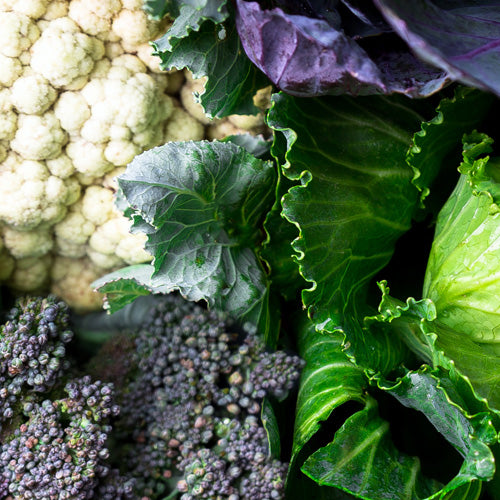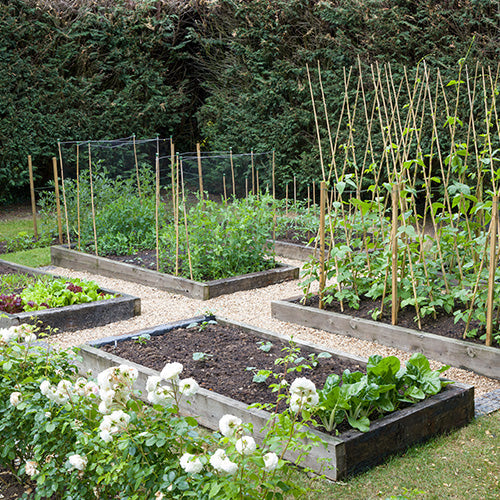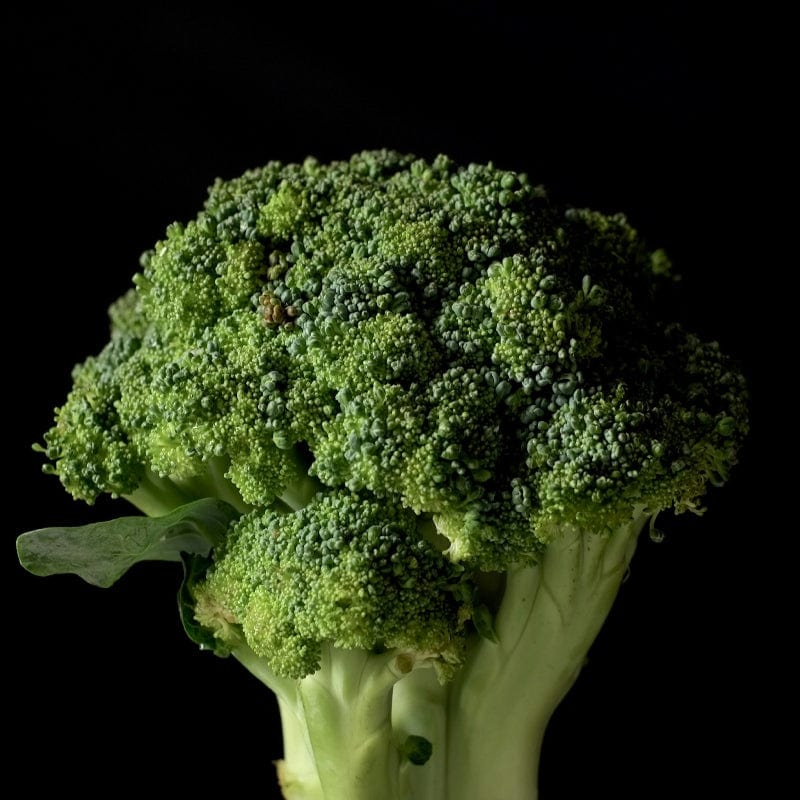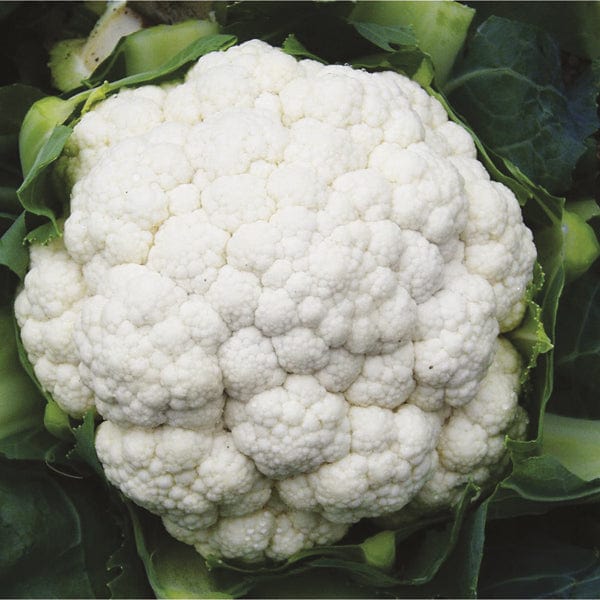Brassicas have always been a popular category with our customers. There are plenty of vegetable to choose from within this family, ranging from hearty cauliflowers to nutritious kale.
We ran a survey and asked our valued customers to submit their top tips for successfully sowing and growing Brassicas. Some have been featured in our catalogues but we thought we would publish these online to allow other growers to benefit...We must add that we haven't tried all of the hints and tips below but it may offer some insights to how other growers approach sowing and growing their brassicas!
Customer Top Tips For Growing Broccoli & Calabrese
Calabrese, which generally crops in summer and autumn, is often called broccoli, especially in shops and supermarkets. The more old fashioned cut-and-come-again sprouting broccolis crop in the spring, both give excellent health benefits and are often referred to as 'superfoods'. They are brassicas and were originally cultivated in Italy, where the name Broccoli was derived from the Latin brachium which means branch or arm. The ubiquitous Calabrese was named after the Italian province of Calabria where it first grew.
Customer Top Tips:
- Never mix up your fertilisers - broccoli & calabrese both need nitrogen, not potash.
- Seed small numbers 6 to 8 weeks apart for continuity. Keep soil firm and put 1 or 2 pieces of rhubarb at the bottom of the hole to fight clubroot.
- When planting brassicas (especially long-stemmed ones such as broccoli and sprouts) dig out a hole slightly less that a spade deep, scatter a little fertiliser at the bottom (I use blood fish and bone) and plant, firm in give a good water. Bank the earth up around the hole ready to bank the plant up as it grows. This ensures the plant is supported during growing and stays damp longer if it is dry.
- These need a lot of strong staking in my area due to strong winds rocking them out of the sandy soil. mulch heavily with garden compost. I grow Feverfew and allow it to flower as it attracts the hoverflies which eat butterfly eggs. encourage small wild wasps to nest in bird boxes near to the veg plot. these wasps eat all the grubs.
- Fill the bed with manure or rough compost to a depth of at least 1 foot and then cover with good quality compost to a depth of 6 inches then tramp down and plant.
- Plant Calabrese at least 12" apart, not just to get better heads but so the heads and secondary growth is easier to see and pick.
Customer Top Tips For Growing Brussels Sprouts
Brussels sprouts are members of the brassica family and it’s thought that a form was first cultivated by the Romans. Brussels sprouts as we would know them date back to the 13th century and were grown in the region of Belgium that gave them their name, the first written reference was in 1587. Modern hybrid brussels sprouts are a revelation for reliability of cropping and the holding power of buttons on the stems. New varieties have a greatly improved flavour and some are so sweet that they are delicious eaten raw, grated into salads.
Customer Top Tips:
- Cover with environmesh when plants first start growing until ready to plant out.
- I do not grow but my father used to say the best place to grow them was where land had been used as a path the previous year
- Dig a hole and fill with well rotted compost, fill the hole sprinkle with lime and plant the sprout in the centre. Firm the soil around the plant with the heel of your shoe then sprinkle chicken manure pellets around the plant and water well.
- As they grow ensure the plants are well supported to prevent wind rocking the plants which causes the sprouts to blow.
- Use a high nitrogen feed. Always support the plants. I sow them indoors in February so that I have nice big strong plants prior to the sprouts forming. They need regular watering.
- Let the remains of the previous season's crop flower before pulling up - the bees love them! Masses of yellow flowers.
- Do not plant in a windy area as they can rock loose in the ground.
Customer Top Tips For Growing Cabbage
The English word cabbage is believed to derive from the French caboche, a colloquial term for head, the wild cabbage Brassica oleracea was a native of western coastal Europe. Species of Brassica have been cultivated for human and animal food since ancient times. We believe the cabbage first appeared in England in the 14th century. Savoy cabbages, however, were not developed until the 16th century. With a little planning you can have cabbages ready for cutting 12 months a year. One of the great standbys of the kitchen garden, they are so versatile.
Customer Top Tips:
- To stop cabbage root fly place a piece of rhubarb about an inch long in the hole i have been doing it for over 50 years and it always works.
- Add plenty of well-rotted manure to the bed. Then lime it and leave it for a few days. When planting, lime the hole you are going to plant in and plant the cabbage plant. Place a circle of cardboard around the plant to protect against cabbage root fly.
- I intercrop these with lettuces as a catch crop. As with all brassicas I protect from caterpillars with a 6mm Netting that is fixed to a moveable frames (I have made several of these over the years).
- All brassica plants beneficent planted on a rotation and to follow pea and beans.
- Plant deep with rhubarb. Raise soil level as the plants grow.
- Grow under a mesh cover.
Customer Top Tips For Growing Cauliflowers
The cauliflower did not become widely grown until the 18th century. Today cauliflowers are a major commercial crop in the United Kingdom, the three main types are named according to their season of harvest - winter, summer and autumn.
Customer Top Tips:
- Once you manage to get a head to form, fold over the inner leaves to protect them from the light, and sit by them watching for predators or you'll have nothing to eat!
- Seed and plant small numbers continuously. As soon as flower starts to develop cover it by turning in its own leaves. Keep doing this till flower is required size. This protects from both sun and rain. Clapton cauli is great and wins prizes at annual show.
- A rich soil is essential so manure and Chicken Manure pellets are a must-do. make sure they are planted at an adequate spacing - they do not respond well.
Customer Top Tips For Growing Kale
Kale belongs to the Brassica family and is one of the most trouble-free, hardy species amongst them. This extremely forgiving vegetable has grown on European soil for at least 3,000 years, before it spread with a cultivation boom to all corners of the Earth. This sped up diversification within each variety, as it thrived in new climates. Recently classed as a ‘superfood’ Kale is seeing another global boom with varieties ranging in colour, flavour and culinary uses, to suit every taste.
Customer Top Tips:
- Much the same as the other green leafy veg: firm well in, feed copiously with nitrogen-based fertiliser & never let them dry out....oh, and net them against cabbage whites!
- Grow two different types, dwarf and Nero are quite different and taste different too.
- Easy to feel given space and a lined but pre-manured plot. High Nitrogen user.
- Cover to discourage pigeons and white butterflies. Spray plants with seaweed spray several times in the year.
- Sow as plug plants then plant out. Like lots of manure mixed in with garden compost.
- Kale is quite resistant to pigeon attack. Dwarf kale is a good cropper and lasts a LONG time.
- I usually grow the Italian kale now, and sow some later in the year for overwintering. Sow in container, prick out then plant up to grow, then plant out when large enough.











